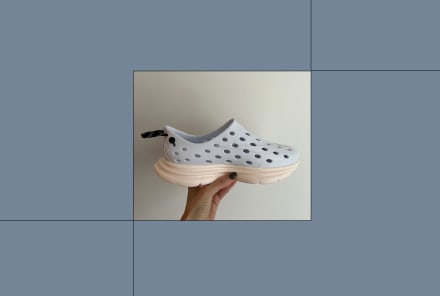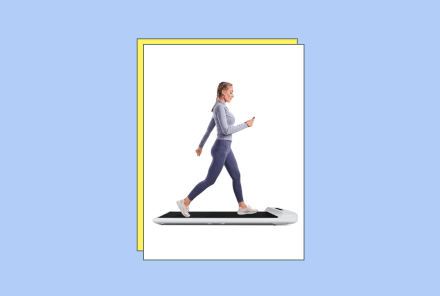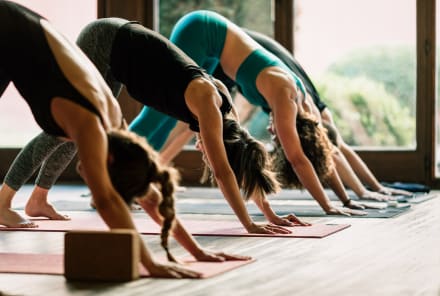Advertisement
How To Build Strength For A Forearm Stand Practice

Being "good at yoga" does not mean being able to do the most advanced version of every pose. It means working patiently and lovingly, wherever you are. Being gentle with ourselves means we are practicing ahimsa, or non-harm.
What I love about yoga is that it provides a format to make progress toward tangible goals. You see someone do a beautiful asana, and when you try it you just can't do it. But then you continue to come to your mat every day and practice, and you gradually get closer to your goal.
Whenever I remind myself that I used to struggle with Chaturanga Dandasana (aka low push-up), I am inspired to continually work toward poses that are seemingly out of my reach.
Last year, I made it my goal to achieve a forearm stand (Pincha Mayurasana). It's a fun, challenging, beautiful asana that requires building up a lot of strength in the shoulders, arms and back.
Here are some of the drills I incorporated into my regular practice every day until I was strong enough to support myself in forearm stand. Start by holding each pose for 30 seconds and increase your time by 10 seconds each week. When you feel ready, kick up into a forearm stand against a wall to start, until you feel strong and stable enough to hold the pose without support.
Remember to be patient, disciplined and gentle with yourself as you build the foundation needed to succeed in this pose. That's more important than the pose itself anyway!
As always, before you begin any practice, warm up with a few rounds of Cat/Cow and/or Sun Salutations.
Forearm Plank (Makara Adho Mukha Svanasana)
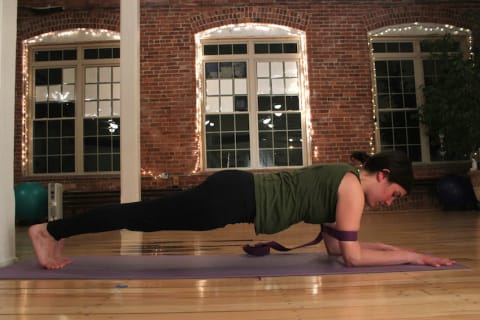
Begin on your hands and knees. Cross your arms in from of your chest and grab your biceps with opposite hands. With your arms this far apart, loop a strap just above your elbows.
Place your forearms parallel to each other on the ground, elbows directly under your shoulders. Rotate your forearms facedown on the ground. Extend through your legs, pressing the balls of your feet into the mat and extending out through your heels.
Keeping your core strong and engaged, make sure your hips are in line with your ribs. Draw your shoulder blades onto your back and lift your chin out of your chest.
Breathe deeply. You can modify this pose by keeping your knees on the ground or making a triangle shape with your arms by clasping your hands together.
Dolphin Pose (Makarasana)
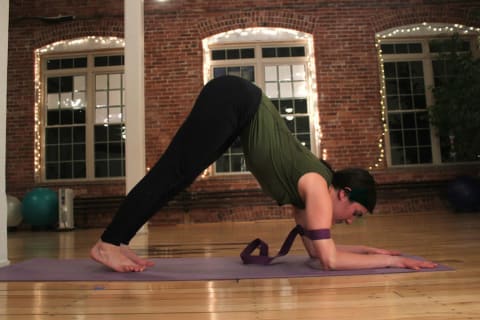
Keep the strap around your upper arms in forearm plank, and walk your feet in toward your elbows.
Continue lifting through your tailbone as you would in Downward Dog. Press your forearms firmly into the mat and lift through the shoulders, drawing your shoulder blades onto your back.
As you get stronger, walk your feet in closer to your upper body, shifting more and more of your weight into your shoulders and arms.
Dolphin Pose With One Leg
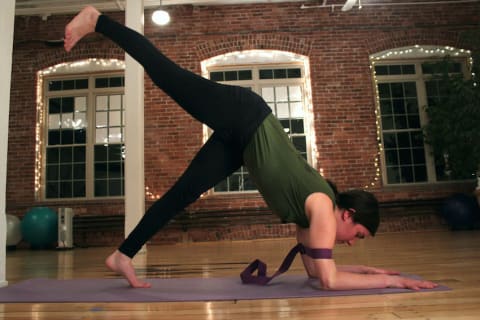
Continue to maintain the correct alignment of Dolphin Pose in your upper body. Lift your right leg off the ground, pressing into the air with the ball of that foot. Hold here and breathe.
Try to keep the toes of your right foot pointing down toward the ground. Repeat on the left side.
Forearm Stand (Pincha Mayurasana)
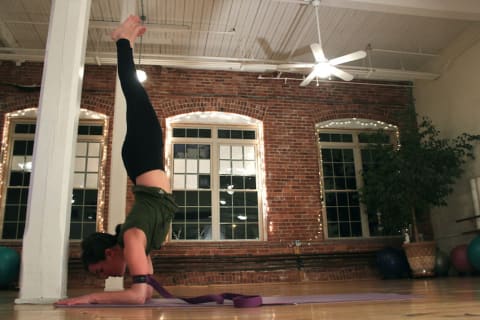
Come to Dolphin Pose with your gaze down between your wrists. Walk your feet in closer to your elbows. Be sure to keep drawing your shoulders onto your back.
Press your arms firmly into the mat and lift your right leg, much like you did for One-Legged Dolphin. Let your left leg follow, as you kick yourself up to the wall while keeping your core engaged.
Once you are up, lift your shoulder blades toward your tailbone, creating space for your neck. Squeeze your legs together and press out through the balls of your feet.
When you're ready to come down, rest in Child's Pose. And when you're ready to give it a try without the wall, go for it! You may want to have a spot or a professional with you when you try this pose for the first time to prevent injury and give you some feedback on your form.
Gallery courtesy of the author
Watch Next
Enjoy some of our favorite clips from classes
Enjoy some of our favorite clips from classes
What Is Meditation?
Mindfulness/Spirituality | Light Watkins
Box Breathing
Mindfulness/Spirituality | Gwen Dittmar
What Breathwork Can Address
Mindfulness/Spirituality | Gwen Dittmar
The 8 Limbs of Yoga - What is Asana?
Yoga | Caley Alyssa
Two Standing Postures to Open Up Tight Hips
Yoga | Caley Alyssa
How Plants Can Optimize Athletic Performance
Nutrition | Rich Roll
What to Eat Before a Workout
Nutrition | Rich Roll
How Ayurveda Helps Us Navigate Modern Life
Nutrition | Sahara Rose
Messages About Love & Relationships
Love & Relationships | Esther Perel
Love Languages
Love & Relationships | Esther Perel




